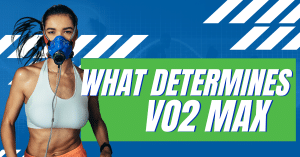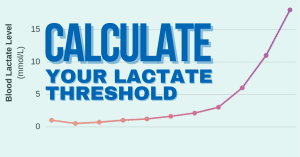Find a training program that works for you is an essential component to achieving your goals. Not only do you need to find a plan that fits with your individual strengths and weaknesses, but you need to believe strongly in the philosophy behind the plan.
My biggest mistake early in my running career was believing I knew it all. As such, I never put my full faith in the training philosophy of my coach.
I thought there was a better way, I’d get caught up in the latest “fad” training idea, and I always wanted more mileage and harder workouts.
The problem with this approach is that it’s short-sighted.
I focused on the immediate aspects of one “training system” but didn’t try to think long-term about the philosophy – how did things fit together, how did it compare, what were the strengths and weaknesses.
Once I understood this, I was able to better compare specific training philosophies and training plans and find what worked for me. When that happened, I developed the trust in the system that allowed me to record new PRs after months of bad races.
As a coach now, I am frequently asked how our training philosophy and training schedules at RunnersConnect compare to some of the other well-known and popular training plans available.
This is a great question because I believe, like I was in my own training, you can only be truly successful if you believe in the plan. Having faith in your plan and understanding its nuances helps build confidence in your fitness and abilities.
In this article, I am going to outline the differences between our training philosophy or approach to the 5k and 10k compared to some of the more popular plans or programs available.
Some notes before we get started:
1. I can only compare our philosophy to those I know well, have studied, or worked under myself. If I don’t mention a coach/program specifically, let me know in the comments and I can try do some research. However, the plan must be publically available in some way.
2. It’s important to remember when comparing any two training philosophies that there isn’t only one way to train. While there are certainly training concepts that apply universally, the specifics of how to approach a race can be different. Obviously, each coach believes in their system.
3. If you have no intention of ever using us as coaches, that’s ok. I still think this can be a valuable read as you’ll get to learn different approaches to training and definitely some ideas you can implement in your own plan.
4. This comparison is in no means written as a way to besmirch any of the following plans or coaches. I actually really like some of them. It’s simply a means to compare our differing approaches to the same goal – helping you run faster.
5. Finally, I have no doubt that for the plans mentioned below that offer personalized coaching options they would accommodate your needs. This is simply a comparison of philosphies based of generally available plans and literature produced.
Ready to get started? Jump to your favorite race distance…
First, it’s helpful if you know our overall approach to training so you have something to compare it to if you’re not currently coached by us.
The RunnersConnect philosophy
From general to specific
Our overall approach to 5k and 10k training is that as a runner gets closer to race day, we want their workouts and training to become more and more specific to the demands of the race.
This progression is generally called “general to specific”. In essence, your training is split into two these two phases – general and specific.
Phase 1: The general phase occurs at the start of your training cycle and is designed to slowly build each energy system to its highest fitness before starting the race specific phase.
During the general phase you slowly build upon each component (speed, strength, long run, mileage) so that no particular energy system is left behind. You start at whatever fitness level you’re at and by the end of the training cycle, your aerobic development, speed, and threshold are at their maximum levels simultaneously. Here’s a good way to visualize how this works:
The general phase can also be broken down into subsections with a particular focus. For example, if you’re a little weak on speed, workouts can have a more speed development focus whereas if you need to develop your aerobic system, you can target more threshold runs in this phase
Phase 2: The race specific phase is typically 6-8 weeks long, depending on your fitness level and training history. It occurs directly after the general phase and comprises the last 6-8 weeks of your training before the race.
As the name implies, race-specific training means training to the specific physiological demands of your race distance.
In a 5k and 10k specific training phase, your goal should be to improve your speed endurance – your ability to maintain and hold a fast pace for the entire race. The more you can develop and target this system, the faster you will be able to race.
In almost all runners we coach, our goal is to build them up to their highest level of overall running fitness during the general phase and then target their training specifically in the final 6-8 weeks.
Focus on aerobic development
The major mistake most runners make when training for the 5k or 10k is neglecting the aerobic system. Many of us view the 5k and 10k as “speed training”, yet the aerobic system plays a pivotal roll in 5k and 10k performance.
You can see from the research summarized in this chart that the aerobic system comprises 85-90% of the energy demands for a 5k or 10k race:
More importantly, development of the aerobic system is the single most important factor for long-term progress.
Therefore, for both short-term and long-term gains, we try to build as much aerobic work into your training plan as possible through long runs, targeting the right easy paces, and ongoing threshold work.
Speed endurance more important than speed development
From a training standpoint, speed is rarely the limiting factor in how fast you can race, even for a distance as “short” as the 5k. Yet, when most runners approach us for help improving their PRs at shorter distances they almost always tell us they need to “work on their speed”. But is this really the case?
Let’s use an example: If you want to run 20 minutes for the 5k (or use your own 5k goal), you need to average 6:25 pace per mile. Technically, that means the fastest pace you need to be able to run is 6:20 per mile.
If you’re currently a 21-minute 5k runner, I have little doubt you can run a 6:20 mile; you’re probably capable of running a mile close to sub 6 minutes.
Thus, the problem isn’t that you don’t have enough speed to run a 20-minute 5k, it’s that you lack the endurance to run three 6:25 miles without stopping.
This is what we call speed endurance – your ability to maintain and hold a fast pace for the entire race – and it’s the major focus of your race specific phase.
That’s not to say we ignore speed development all-together. Like I discussed in the section on the purpose of the general phase, it’s important to touch on all training systems throughout a training cycle.
We definitely include speed development workouts in 5k and 10k training. However, we also “sneak” speed development work into the plan by including strides, hill sprints, drills and other subtle, yet effective speed development training elements.
Hopefully, that helped give you an overview of our philosophy and how our plans are structured. If you feel we could be more in-depth, let us know in the comments section or join our upcoming 5k and 10k training webinar and see the plan in action with specific workouts.
Hal Higdeon, RunnersWorld, Active 5k/10k plans
Most of these 5k and 10k plans on these three sites are designed the exact same way; if you looked at each of these plans on a calendar, it would be difficult to tell them apart.
Again, not that this is wrong. These plans all follow the same philosophy and thus they should look very similar (which is why I have grouped them together here).
The Hal Higdeon, RunnersWorld and Active plans typically only provide the final 6-8 weeks of training. Therefore, I can’t comment too specifically on how they approach the build-up to these workouts or what the philosophy is long-term.
Overall plan structure
The overall philosophy of these three plans is a pretty basic, old-school training structure: One VO2max or speed session early in the week, a tempo session the second half of the week, a fast run on Saturday and a long run on Sunday.
The plans use the same pattern week-after-week, with the same exact workouts, incrementally increasing the mileage of each workout through the cycle.
While I find this approach ignores both the concept of periodization and race-specific training, I think it’s actually helpful for beginners who are intimidated by workouts late in a training cycle.
Most beginners get a plan and immediately look at the final few weeks of the schedule. When the workouts look complicated (as race-specific workouts do) or it’s not clear how you’re building to do them (as is the case with periodization) it’s very intimidating. The approach these plans use makes it very clear how you’re going to take the next step each week. In essence, it makes it very easy to have confidence in these plans, which is a definite plus for new runners.
In addition to a focus on race-specific workouts in the final 6-8 weeks, our approach tries to incorporate a variety of of workouts to attack your physiological systems from different angles.
As an example, I believe there are three types of thresholds – aerobic threshold, lactate threshold, and anaerobic threshold. While a “tempo” run can mean targeting any of of these three subtly different systems, I prefer to specifically attack each one with different types of workouts. We incorporate cutdowns, alternating tempos, lactate clearance tempos, and steady runs.
Not only does this add variety, but I find it helps strengthen specific physiological systems more distinctly and allows for better long-term progression.
Speed versus speed endurance
As discussed in-depth above, I believe speed workouts should focus more on speed endurance rather than pure speed or VO2 max and it’s a major difference in our approach to training for the 5k and 10k.
Speed endurance workouts improve the speed component of 5k or 10k fitness, but don’t specifically target your ability to hold a fast pace for an extended period of time, which I believe is the critical piece to racing faster.
To further expound on this idea, lets compare a traditional interval workout to a speed endurance workout.
One problem with traditional interval workouts that are run at a consistent pace is that the recovery between those intervals allows the athlete to recover to a state that is very unlike the corresponding point in a race. To illustrate this concept, here is what the effort levels of a typical interval workout looks like:
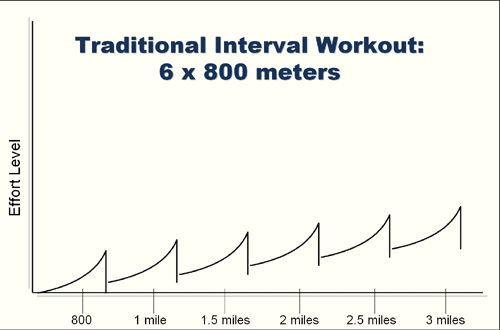
However, we know that’s not how you typically feel or what you experience during a 5k race. In reality, you need to increase your effort as the race continues, adapt to increasing levels of fatigue, and to push through the discomfort.
Unlike a traditional interval workout shown above, running goal pace in mile 2 doesn’t require the same effort as mile one. To illustrate this point, here is a graph of what a typical race effort feels like:
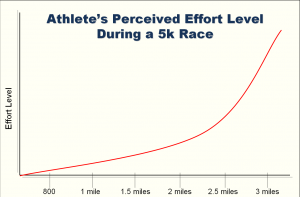
What we need to do is train your body how to run goal pace while tired, under duress, and without the extended rests that allow you to fully recover.
That’s why a workout like 6 x 800 meters at goal race pace with 200 meters quick jog rest is far more race-specific than a traditional VO2max workout.
In this instance, you’re teaching yourself how to run 5k pace with as little rest as possible. By not fully recovering and jogging quickly between repeats you still improve your ability to run at race pace, but you ensure you have the aerobic strength and support to maintain goal pace on race day.
In short, lots of runners have found success with these basic plans and I think they can be a great starting point. But, if you want to take your race times up a notch, you simply must include race-specific training and start thinking about the demands of the race distance.
McMillan 5k and 10k training comparison
McMillan doesn’t offer too many free plans or samples we can use, but luckily I have worked with enough athletes who’ve used his plans and I have read many of his articles, so I think I have a good grasp on his training philosophy.
The pyramid model
The main difference between RunnersConnect and McMillan is how we approach the phases of training. McMillan envisions the base or general phase like a pyramid. The pyramid model is based on the idea that you begin with a large aerobic base, transition to strength work such tempo runs and hill work, add in speed work, and then peak at the end of the training cycle. Here’s a good illustration:
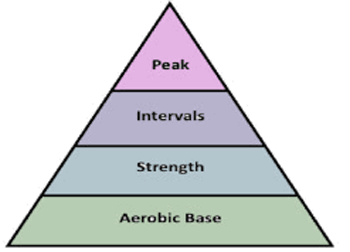
McMillan’s methods and this pyramid idea are based mostly off the Lydiard system, which has been shown to be highly successful, specifically because of it’s focus on aerobic development.
However, my main argument against the pyramid model is the notion that aerobic development, lactate threshold, and speed have to be trained independently of each other.
I believe, if done correctly, you don’t have to run months of just mileage or taper off your tempo runs as you introduce speed work.
Second, when you train using the typical pyramid model, you’re forced to revert back to a base building period after each training cycle and you lose many of the of the strength and speed gains you’ve made at the top of the pyramid. Therefore, you spend a good portion of your next training cycle just trying to get back to that level of speed and strength, instead of constantly improving the current point that you’re at.
My approach is to use what we call the “diamond” model in the general phase, which is designed to slowly build each energy system to its highest fitness before starting the race specific phase.
During the general phase you slowly build upon each component (speed, strength, long run, mileage) so that no particular energy system is left behind. You start at whatever fitness level you’re at and by the end of the training cycle, your aerobic development, speed, and threshold are at their maximum levels simultaneously. Here’s a good way to visualize how this works:
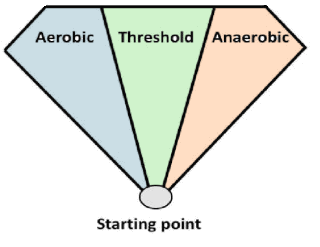
The general phase can also be broken down into subsections with a particular focus. For example, if you’re a little weak on speed, workouts can have a more speed development focus whereas if you need to develop your aerobic system, you can target more threshold runs in this phase. When doing this, I think there are ways to target both or multiple systems, for example by doing a combo workout (tempo run followed by interval work).
Finally, as discussed above, rather than “sharpening” at the top of the pyramid, the RunnersConnect philosophy is to continually get closer and closer to the specific demands of the race with each workout.
Here’s a sample 6 week ADVANCED progression we might use (this is just the 5k specific work, not the tempo, mileage or long runs and is obviously not customized):
- Week 1: 2-3 mile warm-up, 11 x 400 meters at 5k goal race pace with 100m jogging rest, 1-2 mile cool down
- Week 2: 2-3 mile warm-up, 8 x 600 meters at 5k goal race pace with 100m jogging rest, 1-2 mile cool down
- Week 3: 2-3 mile warm-up, 6 x 800 meters at 5k goal race pace with 200m jogging rest, 1-2 mile cool down
- Week 4: 2-3 mile warm-up, 12 x 400 meters at 5k goal race pace with 100m jogging rest, hammer #10 as fast as you can, 1-2 mile cool down
- Week 5: 2-3 mile warm-up, 8 x 800 meters at 5k goal race pace with 200m jogging rest, hammer #6 as fast as you can, 1-2 mile cool down
- Week 6: Race week 2-3 mile warm-up, 2 x 1 mile at 3k-5k pace w/5 min rest, 2 x 400 meters at mile pace w/3 minutes rest, 2 mile cool down.
Summary
In summary, I have no qualms with McMillan’s training philosophy. I think it’s great for long-term development and has a proven track record. There is definitely more than one way to train.
I think the only potential downside is that most runners these days participate in a lot of different races during their training cycle, even when they have 1 or 2 big goal races at the end. Personally, I’ve found that the base structure of the pyramid makes it very difficult to race well as you build up. This is totally find for elite runners who are training for a big championship race and are generally fast enough to run well all the time.
On the other hand, using the diamond model allows you to be as fit (generally) as you can be and thus better able to perform for these tune-ups. I think it gives you more confidence and allows you to have more consistent results across the board.
Hudson training systems
Hudson’s training methods and the approach we take here at RunnersConnect are very similar. We both believe that training should progress each cycle from general to specific.
Moreover, as discussed in my comparison to McMillan we both believe that it’s advisable to train all of the systems simultaneously in the general phase to develop overall as a runner.
Perhaps the only difference in how Hudson approaches 5k and 10k training and what we do at RunnersConnect is how long the race specific phase lasts. Generally, Hudson works with more experienced elite runners. As such, they have a larger capacity for work – mileage, long runs, speed workouts. It’s easier for them to jump into a workout like 4-5 x 2000 meters with 3 minutes rest at goal 10k pace without getting hurt or overdoing it.
Generally speaking, I prefer to build-up to these workouts more gradually. Therefore, because we need to start further back (this would obviously be specific to the athlete) we need more weeks in the race specific phase to build to the pinnacle workouts.
Summary
If you’re an advanced runner, you’ll do very well with the Hudson or RunnersConnect approach. They are both modern training plans that implement some of the latest information we’ve learned as coaches.
However, I find the Huson plan to be very aggressive for beginner or intermediate runners. Surely, some can handle it, but it’s important to modify the workouts to your current ability levels (and as noted at the start, if you were coached by Brad he would surely modify them for you – he hates template plans about as much or more than I do).
Our individualized approach
Like many coaches, I am not a big believer in stock or template training plans. I strongly believe that there is too much individual consideration that needs to be taken into any training schedule.
Yes, I understand I am in the business of selling training and coaching, but I still believe a personalized plan is always going to be better than a stock plan – regardless of the training philosophy.
Specifically, mileage, number of training days and paces are critical elements of a training plan that are trivialized by template schedules. They simply assume that you’re running a certain number of miles or days per week based on your “experience level”.
However, beginner, intermediate and advanced designations for a runner can vary widely in mileage and tolerance for training. The only mileage progression and total that will work optimally for you is one that takes into account your background and injury history.
Likewise, factoring in your strengths and weaknesses is critical to maximizing the effectiveness of a training plan.
By targeting your weaknesses and using your strengths to your advantage you can ensure that each and every workout is progressing you forward.
As an example, a session of 200 meter repeats is somewhat wasted on the runner who has an abundance of natural speed while it’s essential to runners accustomed to marathon success.
Finally, getting your paces correct is essential for targeting the right energy systems.
A lactate threshold run performed at 10-15 seconds faster than your actual threshold means you actually ran zero miles training your threshold and improving that system.
It was a wasted workout.
By getting your training paces correct you can maximize each session.
That’s why we addressed all three of these issues with our custom training plans.
You get a plan specific to your strengths and weaknesses, tailored to your mileage levels, and assigned exact paces to target the right physiological systems.
If you’re interested in receiving a customized training plan based on our training philosophy, you can check out our plans here.
It’s an opportunity to see what a customized, race-specific schedule can look like for you.
We have both monthly and one-time plans for those training for long-term improvement or just want a training plan for their next race.
Hope you enjoyed this little comparison!


